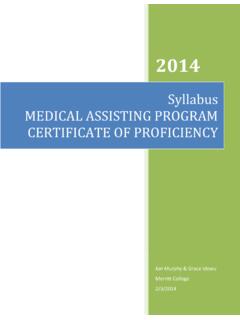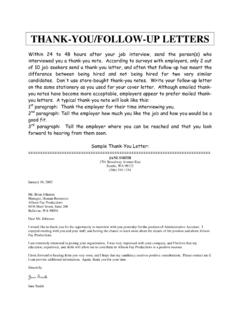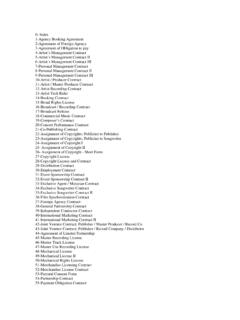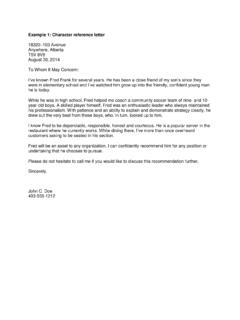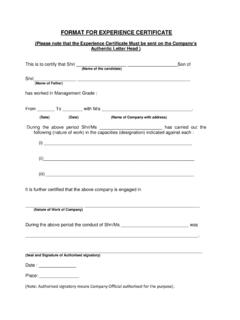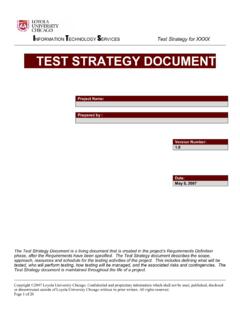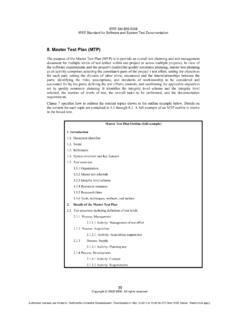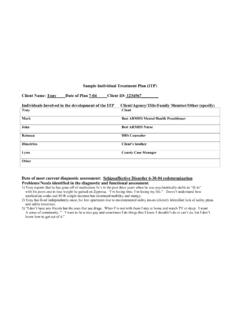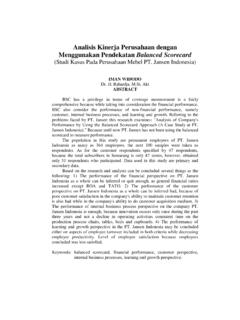Transcription of Strategy Maps and Balanced Scorecards
1 Strategy Maps and Balanced Scorecards Using Business Tools to Align Strategies and Communicate Value Professor Sheila Corrall Information School, University of Sheffield Measurement and Communication Strategy maps and Balanced Scorecards constitute the measurement technology for managing in a knowledge-based economy. By translating their Strategy into the logical architecture of a Strategy map and Balanced scorecard , organizations create a common understandable point of reference for all their units and employees. (Kaplan & Norton, 2001: 11) Information School / The University of Sheffield 2010 Strategy Maps and Balanced Scorecards The Balanced Business scorecard A strategic performance measurement framework, providing a comprehensive view of business performance and relating measurement to Strategy , vision and mission invented by Kaplan & Norton (1992, 1996).
2 Balanced Business scorecard A strategic performance measurement system enabling broader assessment of organisational performance than traditional indicators Helps managers look beyond financial metrics and physical assets to customer measures and intellectual capital ( innovation and learning) Combines 20-30 measures from 4 perspectives to give a fast but comprehensive and Balanced view of how an organisation is performing Information School / The University of Sheffield 2010 (Kaplan & Norton, 1992) Paul Arveson 1998 The Balanced Business scorecard 4 Perspectives on performance Financial or shareholder Customer or service Internal process Innovation and learning (Kaplan & Norton, 1992, 1996) Benefits of the Balanced scorecard Not only provides a fast comprehensive view of business performance, but also connects measurement with Strategy and vision In addition, the customer focus encourages organisations to direct management attention towards critical processes (rather than functions)
3 The Balanced approach has made the system popular with organisations in the public sector and with academic, national and public libraries Information School / The University of Sheffield 2010 Strategic Outcomes Mission Why we exist Core Values What we believe in Vision What we want to be Strategy How we plan to get there Balanced scorecard How we will know that we have arrived Strategic Initiatives What we need to do Personal Objectives What I need to do Satisfied Stakeholders Delighted Customers Effective Processes Motivated and Prepared Workforce Translating a Mission into Desired Outcomes (Kaplan & Norton, 2001: 73) Information School / The University of Sheffield 2010 The Mission Funder Perspective Customer Perspective Internal Perspective Learning and Growth Perspective If we succeed, how will we look to our taxpayers (or donors)?
4 To achieve our vision, how must we look to our customers? To satisfy our customers and financial donors, which business processes must we excel at? To achieve our vision, how must our organization learn and improve? Balanced scorecard for the Public Sector (Kaplan & Norton, 2004: 8) Customer/service perspective How do we look to our clients? Goals Quality Penetration Measures Satisfaction rating ( evaluations by students of teaching) Participation levels ( % taught units where IL embedded) Innovation/learning perspective Can we continue to improve? Goals New modes Expertise Measures Online products ( custom VLE tutorials) Qualifications gained ( PGCert in L&T) Shareholder/financial perspective How do we look to our funders? Goals Economy Growth Measures Unit costs ( marking student bibliographies) Income generated ( IL courses delivered to local businesses and professionals) Internal/process perspective What must we excel at?
5 Goals Reliability Efficiency Measures Percentage downtime Trainee hours per member of teaching staff Information Literacy scorecard Lessons Learned from BSC Deployment 1. Define and communicate clearly the library mission. 2. Ensure strong leadership and management support. 3. measure the right things, not everything. 4. Aggressively communicate the performance results to the library s constituency. 5. Align incentives creatively to the BSC metrics and find new ways of motivating staff. 6. Make change based on BSC analysis, and demonstrate that change is data driven. Information School / The University of Sheffield 2010 (Lloyd, 2006) Critical Success Factors Strategy Mapping A Strategy development and strategic management system, which uses Kaplan & Norton s (1992) four perspectives to define goals and show their cause-and effect relationships in an easy-to-read one-page summary that can be communicated throughout the organisation.
6 Strategy Maps Concept introduced by Kaplan & Norton (2000) as a framework for developing and implementing strategies based on the Balanced Scoredcard perspectives Strategy maps use the BSC framework to define objectives related to the four perspectives and then display their important cause-and-effect relationships They enable managers to capture their plans in an easy-to-read one-page graphical summary and to connect vision, Strategy and resources at all organisation levels A key feature of the model is its emphasis on communicating the Strategy to the whole workforce Information School / The University of Sheffield 2010 Strategic Outcomes Mission Why we exist Values What s important to us Vision What we want to be Strategy Our Game Plan Balanced scorecard measure and Focus Targets and Initiatives What we need to do Personal Objectives What I need to do Satisfied Shareholders Delighted Customers Efficient and Effective Processes Motivated and Prepared Workforce The Balanced scorecard is a step in a continuum that describes what value is and how it is created (Kaplan & Norton, 2004.)
7 33) Strategy Map Translate the Strategy Library Strategic Plan on a Page Vision and/or Mission (Purpose) statement Strategic (Key) Themes and Objectives grouped under the four Balanced scorecard perspectives Customer Value Proposition or Customer/User Needs Financial Sustainability or Funders Requirements Internal Process or Improving Effectiveness Learning and Growth or Potential (Staff Development) American examples have 12-13 objectives, British examples have 30-31 objectives Information School / The University of Sheffield 2010 Library Strategy Map Contents Visual framework for a library s Strategy A good Strategy map will link together the overall customer value proposition, the desired productivity goals for internal processes the capabilities required from the library itself (staff skills, information technology and leadership), the characteristics of a physical collection and electronic database provision, the budget and other financial resources required to deliver the library s vision Matthews, 2008: 58 Library Strategy Map Guidelines Organizational Readiness Perspective Information Resources Perspective Strategy map template with intellectual capital items (Kaplan & Norton, 2004.
8 55) Examples of Library Strategy Maps German National Library of Science and Technology, Johns Hopkins University The Sheridan Libraries, Leeds University Library, McMaster University Library, University of Virginia Library, University of Warwick Library German National Library of Science and Technology (D ren, 2010: 162) Mission: To advance research, teaching, learning at Johns Hopkins University by providing relevant and significant collections, services, and instruction for faculty, students, and staff. The Sheridan Libraries through the University Libraries Council partners with other Johns Hopkins Institutions libraries to maximize support for our constituents while minimizing costs. Customer Needs Provide productive, user-centered workspaces (virtual and physical) Ensure fast, easy access to resources and services needed for research and teaching Financial Perspec4ve Develop strong support base Internal Processes Communica4ons Programs Opera4onal Efficiency Promote resources and services Expand and preserve access to information including digital library development Create productive research, learning, study, and social space Learning And Growth Recruit, develop, and retain productive highly qualified staff Promote an adaptive, collaborative, diverse, engaged.
9 Innovative workplace Create a culture of assessment and accountability JHU Library Strategy Map Strategy Map Minimize costs Identify and improve processes and infrastructure with greatest impact Integrate and strengthen instructional and research support services and programs Leeds University Library Strategy Map 2006-07 Strategy Map Customer Improve discovery of and access to scholarly resources Create world-class teaching & learning environments Strive for exemplary service that is responsive to user needs Internal Processes Learning & Growth Finances Marketing and Communications Services Operational Effectiveness Promote the Library s role in the discovery, dissemination, and preservation of knowledge Integrate the Library into the University s teaching, learning, and research mission Develop highly-trained, technologically-fluent superlative staff Nurture a healthy, collaborative, and dynamic organization Grow an evidence-based culture Align the Library s budget with the University s mission Increase alternate sources of revenue fundraising, grants and revenue generation Mission: advance teaching, learning and research at McMaster by teaching students to be successful, ethical information seekers, facilitating access to information resources, providing welcoming spaces for intellectual discovery and promoting the innovative adoption of emerging learning technologies Track efficiency and effectiveness of Library programs and services Enhance the Library s commitment to strategic planning Encourage innovation and risk taking Customer Needs.
10 Internal Processes Marketing & Communications Library Services Operational Efficiency Learning And Growth Customer Perspective Welcoming spaces that promote productivity and collaboration Easy access to superb information and resources Services and programs that add value to scholarship Financial Perspective Increase financial base for unrestricted funds Focus on resources & services with high ratio of value to cost Maintain funding levels to responsibly steward the University s knowledge resources Promote Library as intellectual crossroads Develop effective digital services Align administrative, technical, and public service priorities Prioritize strategic programs and adjust budget and staffing accordingly Recruit, develop, and retain productive, highly qualified staff Strategic Skills / Workforce Infrastructure Implement space and technology upgrades to support cutting-edge services and initiatives Culture Promote culture of assessment and accountability Develop community model of leadership and organization Facilitate world-class research, teaching and learning through leadership in the creation, access, use.
